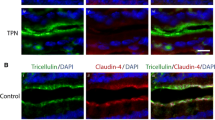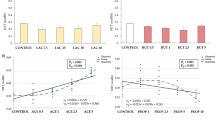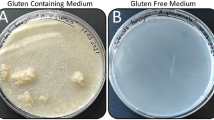Abstract
Background
Nutritional support is an established element of therapy for various indications. However, its impact on the mucosal barrier function is not well understood.
Aim of the study
We investigated the influence of EN and PN on intestinal epithelial cells and peripheral blood (PBMC) and lamina propria mononuclear cells (LPMC), all of which are involved in the mucosal defense against bacterial translocation and systemic inflammation.
Methods
Integrity of epithelial cells was measured as transepithelial electrical resistance (TER) of confluent Caco-2 monolayers in the presence of 1% EN, PN and a parenteral amino acid mixture (AM). To determine wound healing capacities, an established migration model with IEC-6 cells was used. Furthermore, we investigated apoptosis, cell activation, proliferation and cytokine secretion of Caco-2, HT29 and of stimulated PBMC and LPMC cultured with or without 1 and 5% EN, AM or PN.
Results
We demonstrated that EN, AM and PN promoted the integrity of the epithelial monolayer and reconstituted epithelial cell continuity TGF-β-dependently and -independently. Interestingly, only PN induced apoptosis and decreased the mitochondrial membrane potential. The activation status of PBMC was significantly reduced by EN and AM. Specifically, EN leads to an increased apoptosis rate, inhibited cell cycle progression and increased pro-inflammatory cytokine secretion. Both EN and PN reduced the activation status and the release of pro- and anti-inflammatory cytokines.
Conclusions
Our study provides evidence that by promoting wound healing and regulating T cell function, EN, AM, and PN potently interact with the intestinal barrier and immune system, thus justifying its use in diseases accompanied by impaired mucosal barrier function.









Similar content being viewed by others
References
Basson MD, Modlin IM, Flynn SD, Jena BP, Madri JA (1992) Independent modulation of enterocyte migration and proliferation by growth factors, matrix proteins, and pharmacologic agents in an in vitro model of mucosal healing. Surgery 112:299–307
Baumgart DC, Dignass AU (2002) Intestinal barrier function. Curr Opin Clin Nutr Metab Care 5:685–694
Berg RD, Garlington AW (1979) Translocation of certain indigenous bacteria from the gastrointestinal tract to the mesenteric lymph nodes and other organs in the gnotobiotic mouse model. Infect Immun 23:403–411
Blikslager AT, Moeser AJ, Gookin JL, Jones SL, Odle J (2007) Restoration of barrier function in injured intestinal mucosa. Physiol Rev 87:545–564
Debaveye Y, Van den Berghe G (2006) Risks and benefits of nutritional support during critical illness. Annu Rev Nutr 26:513–538
Deitch EA (2001) Role of the gut lymphatic system in multiple organ failure. Curr Opin Crit Care 7:92–98
Dignass AU, Podolsky DK (1993) Cytokine modulation of intestinal epithelial cell restitution: central role of transforming growth factor beta. Gastroenterology 105:1323–1332
Dray X, Marteau P (2005) The use of enteral nutrition in the management of Crohn’s disease in adults. J Parenter Enteral Nutr 29:S166–S172
Edelblum KL, Yan F, Yamaoka T, Polk DB (2006) Regulation of apoptosis during homeostasis and disease in the intestinal epithelium. Inflamm Bowel Dis 12:413–424
Fiocchi C (1998) Inflammatory bowel disease: etiology and pathogenesis. Gastroenterology 115:182–205
Ina K, Itoh J, Fukushima K, Kusugami K, Yamaguchi T, Kyokane K, Imada A, Binion DG, Musso A, West GA, Dobrea GM, McCormick TS, Lapetina EG, Levine AD, Ottaway CA, Fiocchi C (1999) Resistance of Crohn’s disease T cells to multiple apoptotic signals is associated with a Bcl-2/Bax mucosal imbalance. J Immunol 163:1081–1090
Itoh J, de La MC, Strong SA, Levine AD, Fiocchi C (2001) Decreased Bax expression by mucosal T cells favours resistance to apoptosis in Crohn’s disease. Gut 49:35–41
Jeejeebhoy KN (2007) Enteral nutrition versus parenteral nutrition the risks and benefits. Nat Clin Pract Gastroenterol Hepatol 4:260–265
Jiang XH, Li N, Li JS (2003) Intestinal permeability in patients after surgical trauma and effect of enteral nutrition versus parenteral nutrition. World J Gastroenterol 9:1878–1880
MacFie J (2000) Enteral versus parenteral nutrition: the significance of bacterial translocation and gut-barrier function. Nutrition 16:606–611
Mankertz J, Schulzke JD (2007) Altered permeability in inflammatory bowel disease: pathophysiology and clinical implications. Curr Opin Gastroenterol 23:379–383
Mccole DF, Barrett KE (2007) Varied role of the gut epithelium in mucosal homeostasis. Curr Opin Gastroenterol 23:647–654
Minard G, Kudsk KA (1998) Nutritional support and infection: does the route matter? World J Surg 22:213–219
Peluso I, Pallone F, Monteleone G (2006) Interleukin-12 and Th1 immune response in Crohn’s disease: pathogenetic relevance and therapeutic implication. World J Gastroenterol 12:5606–5610
Qiao L, Schurmann G, Betzler M, Meuer SC (1991) Activation and signaling status of human lamina propria T lymphocytes. Gastroenterology 101:1529–1536
Richter A, Lohning M, Radbruch A (1999) Instruction for cytokine expression in T helper lymphocytes in relation to proliferation and cell cycle progression. J Exp Med 190:1439–1450
Sanders DSA (2005) Mucosal integrity and barrier function in the pathogenesis of early lesions in Crohn’s disease. J Clin Pathol 58:568–572
Scaduto RC Jr, Grotyohann LW (1999) Measurement of mitochondrial membrane potential using fluorescent rhodamine derivatives. Biophys J 76:469–477
Schreiber S, Nikolaus S, Hampe J, Hamling J, Koop I, Groessner B, Lochs H, Raedler A (1999) Tumour necrosis factor a and interleukin 1 beta in relapse of Crohn’s disease. Lancet 353:459–461
Steeber DA, Tedder TF (2000) Adhesion molecule cascades direct lymphocyte recirculation and leukocyte migration during inflammation. Immunol Res 22:299–317
Sturm A, Dignass AU (2008) Epithelial restitution and wound healing in inflammatory bowel disease. World J Gastroenterol 14:348–353
Sturm A, Itoh J, Jacobberger JW, Fiocchi C (2002) p53 negatively regulates intestinal immunity by delaying mucosal T cell cycling. J Clin Invest 109:1481–1492
Sturm A, Leite AZ, Danese S, Krivacic KA, West GA, Mohr S, Jacobberger JW, Fiocchi C (2004) Divergent cell cycle kinetics underlie the distinct functional capacity of mucosal T cells in Crohn’s disease and ulcerative colitis. Gut 53:1624–1631
Sturm A, Lensch M, Andre S, Kaltner H, Wiedenmann B, Rosewicz S, Dignass AU, Gabius HJ (2004) Human galectin-2: novel inducer of T cell apoptosis with distinct profile of caspase activation. J Immunol 173:3825–3837
Sturm A, Mohr S, Fiocchi C (2002) Critical role of caspases in the regulation of apoptosis and proliferation of mucosal T cells. Gastroenterology 122:1334–1345
Sturm A, Rilling K, Baumgart DC, Gargas K, Abou-Ghazale T, Raupach B, Eckert J, Schumann RR, Enders C, Sonnenborn U, Wiedenmann B, Dignass AU (2005) Escherichia coli Nissle 1917 distinctively modulates T-cell cycling and expansion via toll-like receptor 2 signaling. Infect Immun 73:1452–1465
Sturm A, Sudermann T, Schulte KM, Goebell H, Dignass AU (1999) Modulation of intestinal epithelial wound healing in vitro and in vivo by lysophosphatidic acid. Gastroenterology 117:368–377
Sun X, Spencer AU, Yang H, Haxhija EQ, Teitelbaum DH (2006) Impact of caloric intake on parenteral nutrition-associated intestinal morphology and mucosal barrier function. JPEN J Parenter Enteral Nutr 30:474–479
Targan SR, Deem RL, Liu M, Wang S, Nel A (1995) Definition of a lamina propria T cell responsive state. Enhanced cytokine responsiveness of T cells stimulated through the CD2 pathway. J Immunol 154:664–675
Wildhaber BE, Yang H, Spencer AU, Drongowski RA, Teitelbaum DH (2005) Lack of enteral nutrition—effects on the intestinal immune system. J Surg Res 123:8–16
Acknowledgments
We thank Anne Carney for critical reading of the manuscript. This work was supported by a grant from the Deutsche Forschungsgemeinschaft (STU247/3-2), the Forschungsförderung of the Charité, Universitätsmedizin Berlin and an unrestricted grant from Travacare GmbH, Hallbergmoos, Germany.
Author information
Authors and Affiliations
Corresponding author
Electronic supplementary material
Below is the link to the electronic supplementary material.
Rights and permissions
About this article
Cite this article
Guzy, C., Schirbel, A., Paclik, D. et al. Enteral and parenteral nutrition distinctively modulate intestinal permeability and T cell function in vitro. Eur J Nutr 48, 12–21 (2009). https://doi.org/10.1007/s00394-008-0754-3
Received:
Accepted:
Published:
Issue Date:
DOI: https://doi.org/10.1007/s00394-008-0754-3




